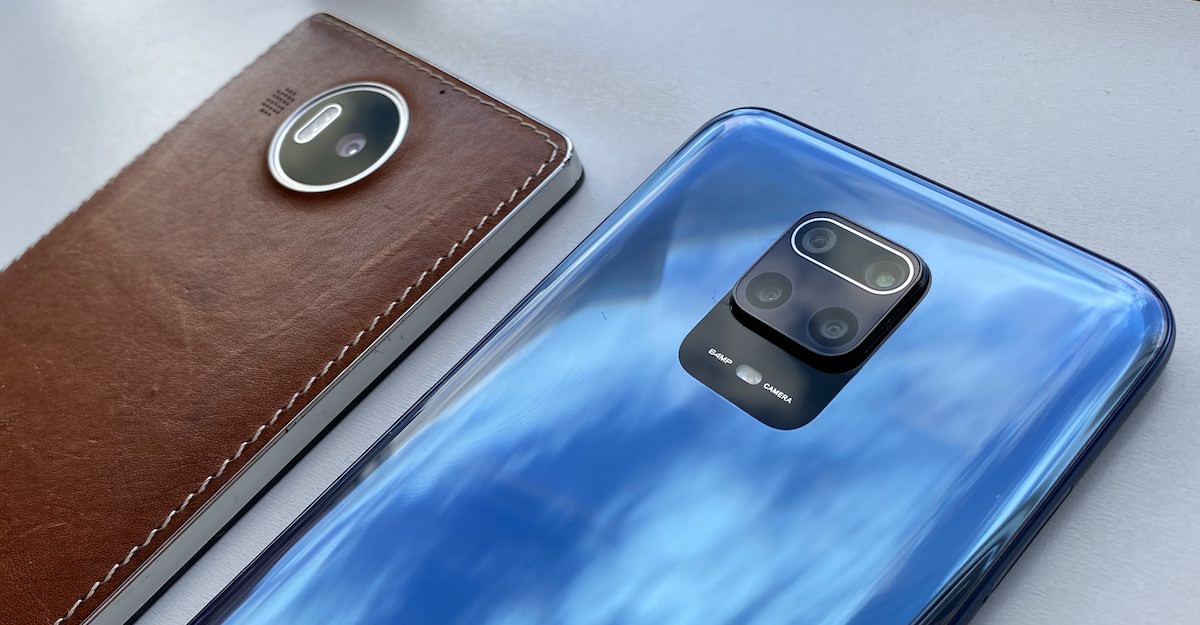
Let's start with a few basic specs:
| Lumia 950 XL (2015) | Redmi Note 9 Pro (2020) |
|
Dedicated shutter button/launch key |
64 MP, f/1.9, 1/1.72", PDAF |
So a higher megapixel, much larger sensor, with Quad-Bayer pixel-binning to 16MP (in 4:3)
Notes:
- I've shot at 4:3 at the default output resolutions on each (leaving headroom for some lossless 'PureView' zoom into the 950 XL's sensor and also getting the advantages of oversampling and noise reduction). Yes, I realise that 8MP on the 950 XL and 16MP on the Redmi makes for crop framing below that's not exact, but it would also have not been exact if I'd allowed the 950 XL to go up to its full 20MP. And then I'd have readers saying that the Redmi should be allowed to go up to its full 64MP and then we're down a rabbit hole! The 950 XL is most 'comfortable' at 8MP, in my opinion.
- The 4:3 aspect ratio isn't fully catered for by Rafe's interactive comparator below - but note the facility to grab the original JPGs if you want to do your own full-frame comparisons.
- All photos were taken on full auto and handheld, as a regular user would do. No tripods or RAW editing sessions needed!
Let's pit the results against each other, using our Famed Interactive Comparator (FIC). All 1:1 crops are at 900x500 for comparison, though I've put up the originals on my own server, for you to download if you want to do your own analysis.
| Note that the interactive comparator below uses javascript and does need to load each pair of images. Please be patient while this page loads, if you see a pair of images above each other than you've either not waited long enough or your browser isn't capable enough! You ideally need a powerful, large-screened tablet or a proper laptop or desktop. This comparator may not work in some browsers. Sorry about that. On Windows 10 Mobile, use the 'AAWP Universal' UWP app, which handles the comparator very competently (see the tips in the app's help screens) |
Test 1: Sunny landscape
Plenty of detail at a petrol station in the sun, shot at about 35m. Here is the overall scene, unzoomed:

You can grab the original photos from the Lumia 950 XL and Redmi Note 9 Pro (2020), for your own analysis.
To look at the images in more detail here, here are fairly central 1:1 crops, from the Lumia 950 XL and then Redmi Note 9 Pro, just wait to make sure the page has fully loaded and then use your mouse or trackpad pointer to compare the images:
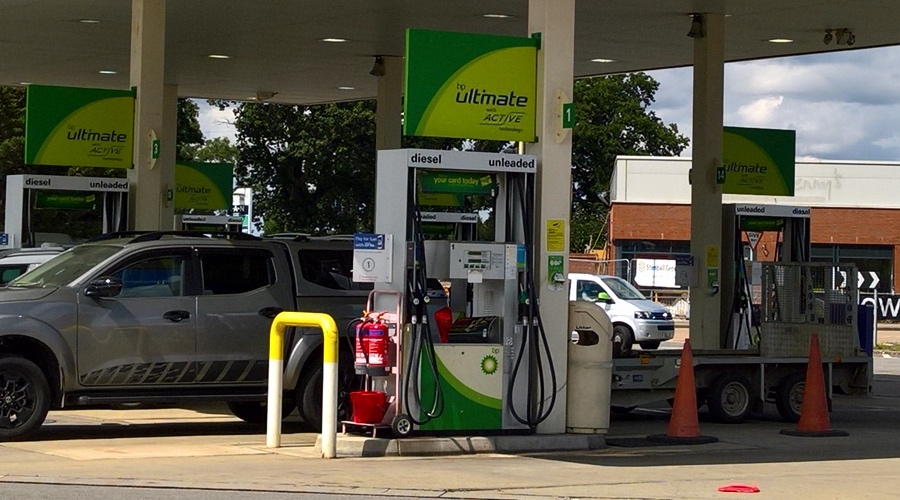
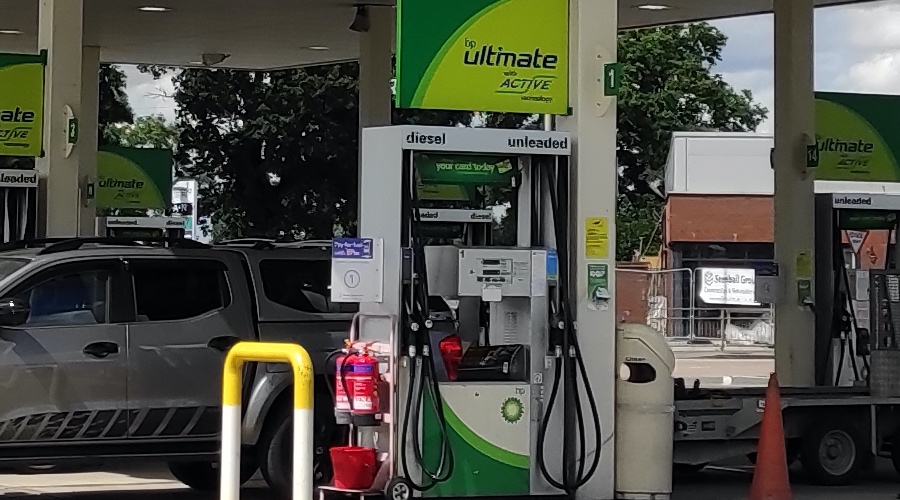
They're both perfect shots in such good light, of course. The extra default resolution favours the Xiaomi device, but only because I'm using the 950 XL's oversampled mode. There's extra sharpening on the Redmi Note 9 Pro, but it's tastefully done and I'm going to give full marks all round.
Microsoft Lumia 950 XL: 10 pts; Xiaomi Redmi Note 9 Pro (2020): 10 pts
Test 2: Sunny landscape, zoomed
The same scene, but zoomed to 2x (using the UI in the Redmi device and approximated on the Lumia). You can grab the original zoomed photos from the Lumia 950 XL and Redmi Note 9 Pro (2020), for your own analysis.
To look at the images in more detail here, here are fairly central 1:1 crops, from the Lumia 950 XL and then Redmi Note 9 Pro, just wait to make sure the page has fully loaded and then use your mouse or trackpad pointer to compare the images:

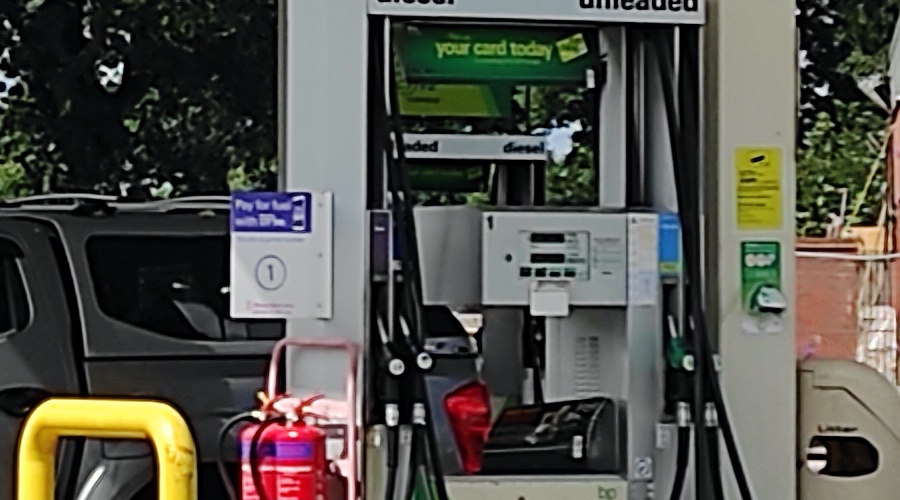
Both are pretty hopeless. In theory, the Redmi Note 9 Pro's 64MP sensor should allow for lossless 2x zoom, but this isn't happening. What's probably happening is that the 16MP unzoomed shot is being cropped and interpolated. Which is 'cheaping out' compared to the miracles that the Nokia 808 and Lumia 1020 did back in the day. Though they had proper RGB Bayer filters, not the kludge that's 'Quad Bayer'. The Lumia 950 XL's never been good at zoom and the higher resolution mess from the Redmi is slightly better - but they're both rubbish!
Microsoft Lumia 950 XL: 5 pts; Xiaomi Redmi Note 9 Pro (2020): 6 pts
Test 3: Wide-angle on large objects
Perhaps playing into the wide angle province of the newer device, but I did want to show the difference in field of view. You can grab the original photos from the Lumia 950 XL and Redmi Note 9 Pro (2020), for your own analysis.
Here are scaled-for-the-web versions, from the Lumia 950 XL's only lens and then the Redmi Note 9 Pro's wide angle lens, just wait to make sure the page has fully loaded and then use your mouse or trackpad pointer to compare the images:
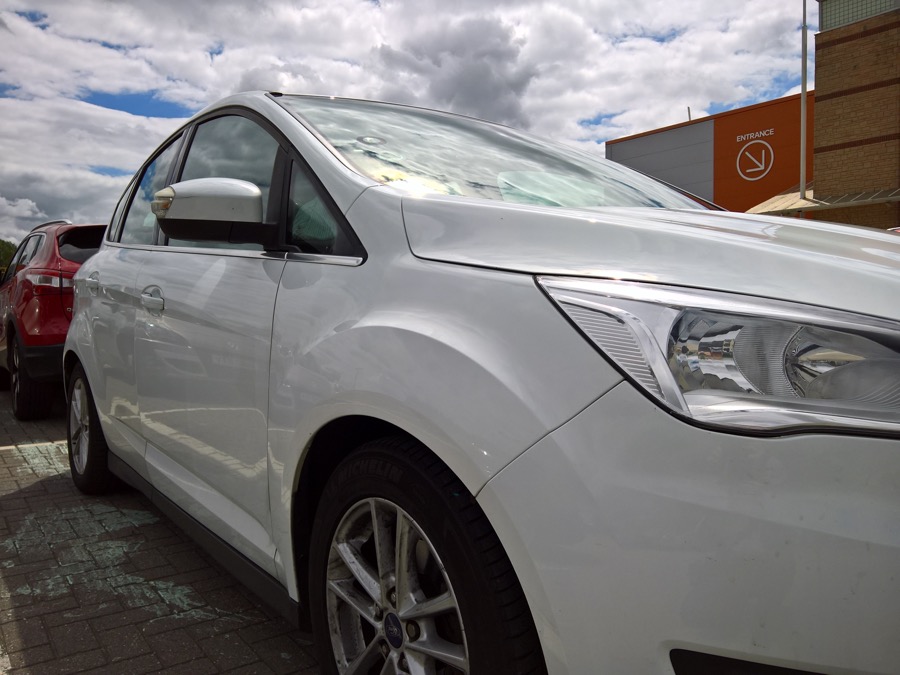

Nothing obviously arty here, but you get the idea. When you want to shoot something - a car, a building - and you can't get back further to get the whole scene in, then a wide angle lens comes in very handy. See my separate wide-angle feature here. Now, the 950 XL's main lens is already fairly wide, but it's outgunned in this department by the dedicated lens on the newer phone. A couple of extra points for the option for the Redmi, I think.
Xiaomi Redmi Note 9 Pro (2020): 2 bonus pts
Test 4: Macro time
Another dedicated lens on the Redmi Note 9 Pro is 'macro', optimised to focus within a few inches. So I tried on this splendid flower against a bright sky. You can grab the original photos from the Lumia 950 XL and Redmi Note 9 Pro (2020), for your own analysis.
Here are scaled-for-the-web versions, from the Lumia 950 XL's only lens and then the Redmi Note 9 Pro's wide angle lens, just wait to make sure the page has fully loaded and then use your mouse or trackpad pointer to compare the images:


Extra points for the macro option for the Redmi, I think - its result is rather splendid and with zero effort. Get within a couple of inches and it focusses smartly and delivers good colour and dynamic range. The Lumia 950 XL's camera does well enough, but it can't focus this close.
Microsoft Lumia 950 XL: 8 pts; Xiaomi Redmi Note 9 Pro (2020): 10 pts
Test 5: Low indoor light
Some Lego boxes with masses of detail, shot at a metre or so in low indoor light (this aisle wasn't very well lit). Here is the overall scene:

You can grab the original photos from the Lumia 950 XL and Redmi Note 9 Pro (2020), for your own analysis.
To look at the images in more detail here, here are fairly central 1:1 crops, from the Lumia 950 XL and then Redmi Note 9 Pro, just wait to make sure the page has fully loaded and then use your mouse or trackpad pointer to compare the images:


You all know my preferences for natural images rather than over-sharpened and this crop comparison is a good example. Xiaomi is clearly doing quite a lot to enhance the edges in these printer illustrations, with the result that the eye is drawn more to detail. And the casual observer would probably pick the Redmi image over the Lumia's. But I prefer the natural edges and natural colours in the Lumia photo, so it gets my vote here.
Microsoft Lumia 950 XL: 10 pts; Xiaomi Redmi Note 9 Pro (2020): 9 pts
Test 6: Low light landscape
Very gloomy, half an hour after sunset, here's a corner of the garden that we've been working on (hey, it'll get finished by the end of summer!) Here is the overall scene, made to look lighter than it actually was:

You can grab the original photos from the Lumia 950 XL and Redmi Note 9 Pro (2020), for your own analysis.
To look at the images in more detail here, here are fairly central 1:1 crops, from the Lumia 950 XL and then Redmi Note 9 Pro, just wait to make sure the page has fully loaded and then use your mouse or trackpad pointer to compare the images:

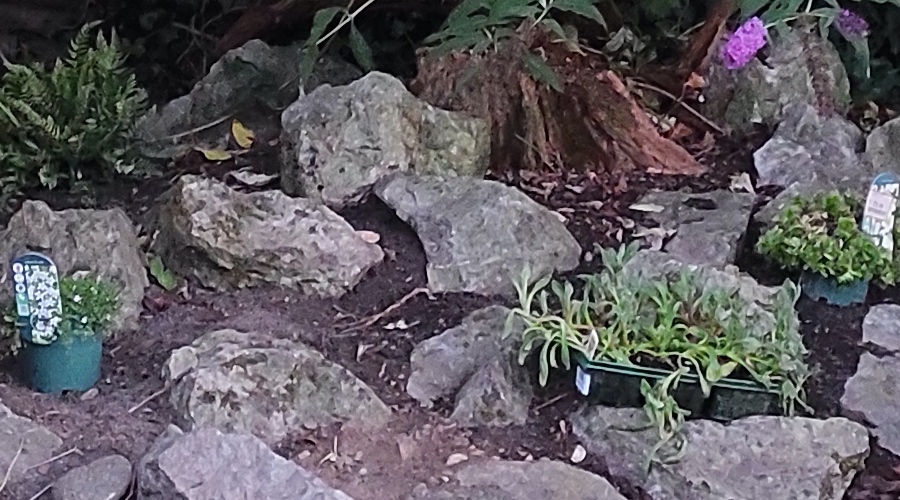
Many people's favourite Lumia is getting outclassed here - the 950 XL's red/purple tinge is off-putting, while the Redmi's image processing works rather well to accentuate the edges of all that stonework. Not perfect in either case, but I'm giving this round to the newer phone camera, against my algorithm expectations.
Microsoft Lumia 950 XL: 8 pts; Xiaomi Redmi Note 9 Pro (2020): 9 pts
Test 7: Very low light flowers
One of my standard tests - our hanging basket lit by just a weedy porch night light - how much colour can the phone cameras capture? You can grab the original photos from the Lumia 950 XL and Redmi Note 9 Pro (2020), for your own analysis.
Here are scaled-for-the-web versions, from the Lumia 950 XL's only lens and then the Redmi Note 9 Pro's wide angle lens, just wait to make sure the page has fully loaded and then use your mouse or trackpad pointer to compare the images:

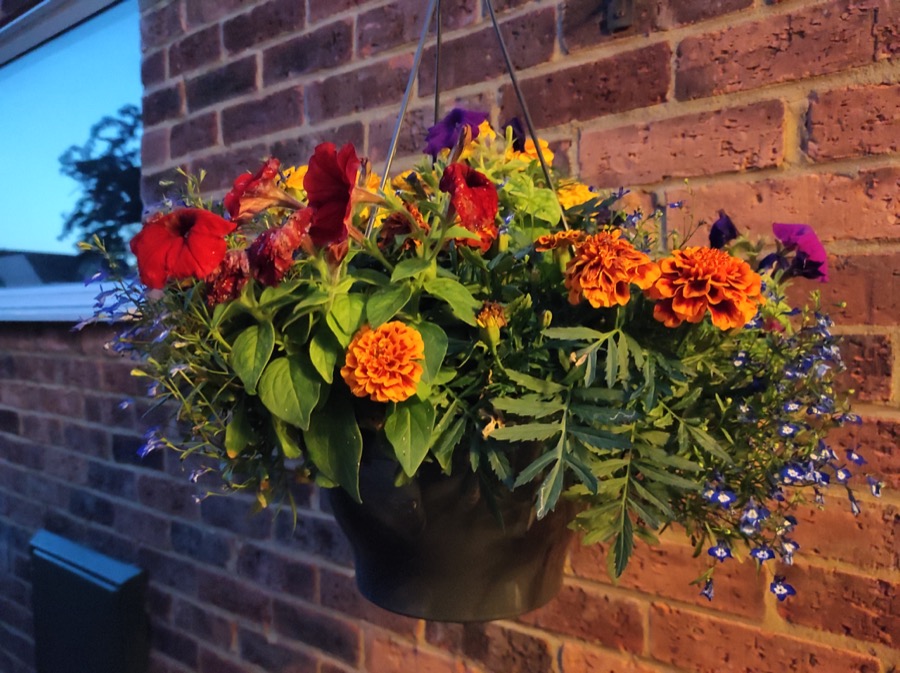
Considering that the Redmi Note 9 Pro's main camera doesn't have OIS, its low light shots are just remarkable. All handheld, it's unclear whether multi-frame capture tricks are used or whether it's picking an optimum moment for the capture, when hands are shaking slightly less. Possibly both. These two shots are both fabulous considering the light conditions and full marks all round.
Microsoft Lumia 950 XL: 10 pts; Xiaomi Redmi Note 9 Pro (2020): 10 pts
Test 8: Night time
My other standard night time test, here shooting a suburban scene around an hour after sunset - as usual, it was much darker than the scenes suggest here. Here is the overall scene:
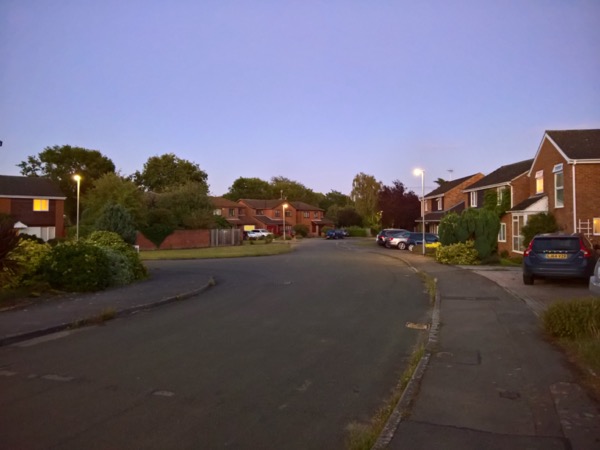
You can grab the original photos from the Lumia 950 XL and Redmi Note 9 Pro (2020), for your own analysis.
To look at the images in more detail here, here are fairly central 1:1 crops, from the Lumia 950 XL and then Redmi Note 9 Pro, just wait to make sure the page has fully loaded and then use your mouse or trackpad pointer to compare the images:
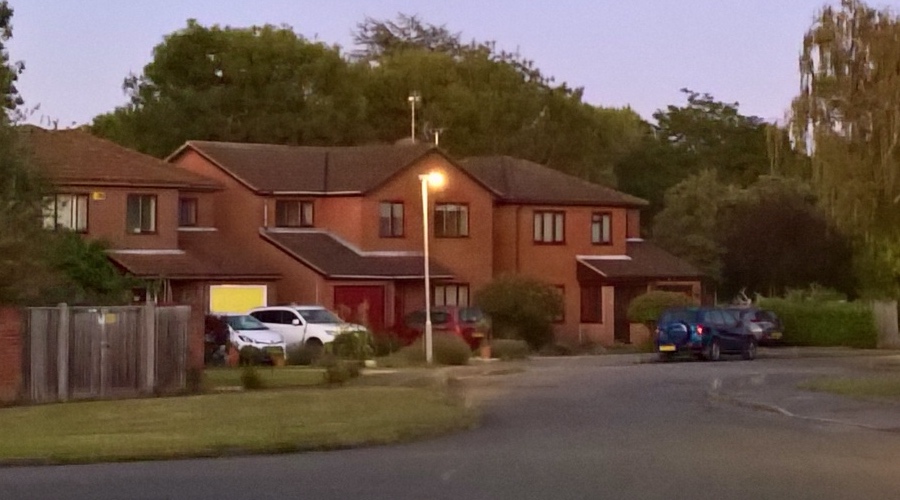
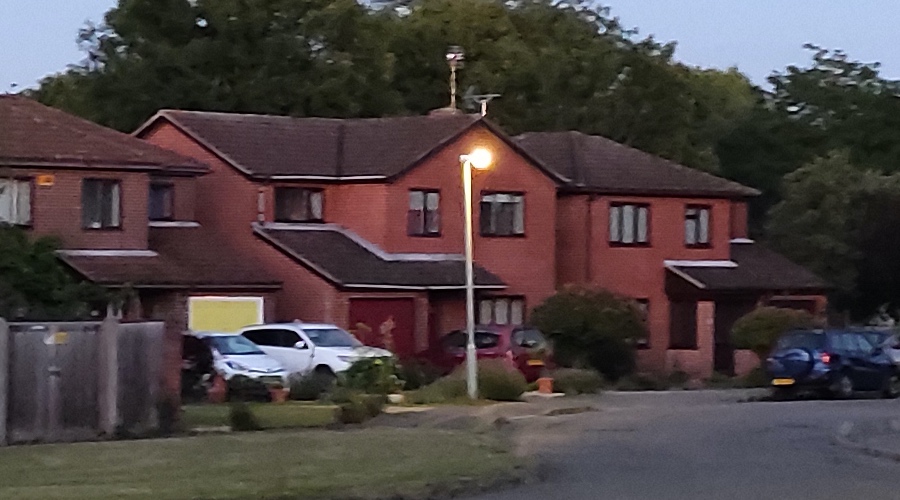
The Lumia 950 XL's great oversampling produces better colours here, but the OIS-less, Quad Bayer Redmi main camera isn't that far behind, surprisingly so. Just some jaggies here and there and a bit more noise. Perhaps two points in it, but a strong showing for a £250 smartphone.
Microsoft Lumia 950 XL: 9 pts; Xiaomi Redmi Note 9 Pro (2020): 7 pts
Test 9: Going wide with Friends
A final example of one of the Redmi Note 9 Pro's extra lenses - this was a Lego example set illuminated in a shop, of the famous Friends coffee shop sofa. The thing with displays like this is that you HAVE to snap them right up against the display glass, to eliminate reflections of the shop/room.
You can grab the original photos from the Lumia 950 XL and Redmi Note 9 Pro (2020), for your own analysis.
Here are scaled-for-the-web versions, from the Lumia 950 XL's only lens and then the Redmi Note 9 Pro's wide angle lens, just wait to make sure the page has fully loaded and then use your mouse or trackpad pointer to compare the images:


Well, the idea's there at least - the wide angle lens managed to get more of the Lego scene in, but both phone cameras had too shallow a depth of field to get much of the scene in focus. The Lumia did best, going for the character faces, while the wide angle on the Redmi is fixed-focus and its depth of field starts at the faces and goes back from there - unfortunately meaning that the extra scenery in the forground is all out of focus.
So a bit of an edge case example, but it does show again how having a wide angle lens on tap encourages creativity and might enable photos you couldn't attempt with conventional means.
Microsoft Lumia 950 XL: 7 pts; Xiaomi Redmi Note 9 Pro (2020): 7 pts
Verdict
For the record, the scores add up as:
- Xiaomi Redmi Note 9 Pro (2020): 70 pts
- Lumia 950 (late 2015): 67 pts
Don't take the narrow victory as that significant, the two phone cameras might be classed as even overall. But what is significant is that the Redmi Note 9 Pro is a 'budget' smartphone at only £250 (or £270 for a 128GB variant). With the Quad Bayer system in modern budget and mid-range phones producing decent low light photography (if not zoom), and with the flexibility of macro and wide angle lenses, there's a lot here to keep a shutter-bug happy. In other words we've got to the stage where you could argue that the Lumia 950 champion from half a decade ago is now being rivalled in the still imaging stakes by relatively low end compeition - it's not just the £1000 flagships.
Yes, a telephoto lens would have been handy too, plus AMOLED for the display, but then we're starting to get up into the £500+ mid-range, whereas this Redmi device will serve as a cheap entry point into the Android world. Or perhaps for an inexpensive phone replacement for another family member.
